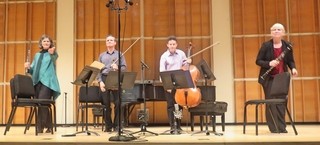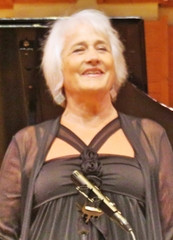|
Back
Triquetra? Pipistrellosamente! New York
Merkin Concert Hall
05/01/2017 -
“Crossing the Musical Waters to Italy”:
Salvatore Sciarrino: Lo spazio inverso
Chester Biscardi: Di Vivere
Arlene Zallman: Triquetra
Harvey Solberger: To the Spirit Unappeased and Peregrine
Judith Shatin: Secret Ground
Stephen Albert: Rilke Song
Luciano Berio: O King
David Rakowski: Thickly Settled
Lucy Shelton (Soprano)
Core Da Capo members: Patricia Spencer (Flute), Meighan Stoops (Clarinet), Curtis Macomber (Violin), Chris Gross (Cello), Steven Beck (Piano)

P. Spencer, C. Macomber, C. Gross, M. Stoops (© Samuel T. Dog)
Nothing was “cute” about the Da Capo Chamber Players music last night. Their eight works were diverse in feeling, the composers (only two of whose names I knew) used no tricks or quotes from others, no jazzy interludes.
But each serious work was a prize in itself, though some extended their feelings more than others obviously. Most notable of all was that the musicians of Da Capo are amongst our finest. Not just in fingerwork, but the feelings which came through.
That is not to say that the music was stolid or pulsed with Boulezian earnestness. Harvey Sollinger’s To the Spirit Unappeased and Peregrine, a tribute for the 60th birthday of the very daunting Charles Wuorinen, was a rollicking duet between Meighan Stoops’ clarinets (including bass) and Patricia Spencer’s flutes (including piccolo). Easy enough to follow the repetitions–a cell on one instrument, a variation on the other–but they tootled and blew so happily and the colors were so varied that this was obviously a birthday gift (with 60 measures for each year).
The final work, David Rakowski’s Thickly Settled was equally engaging, the title referring to signs before New England towns. Here, though, the four players started with a “thickly settled” chord, and then unraveled it over three engaging movements. The lines glossed over each other, falling on themselves, tripping down and rising up. I was trying to find a single measure which wasn’t legato, but all the unending lines from that thick chord played around with some abandon.
(Though my favorite part was the direction for the third movement: Scherzo: Pipistrellosamente!! Love it!)
Equally engaging–for a different reason–was Arlene Zallman’s Trio Triquetra, the latter referring to an architectural form, and of no interest. Instead, Ms. Zallman presented a three-movement totally Classical form, which was structured without force, without an evident Prokofiev “Classical” imitation. The harmonies were dissonant, the piano, violin and cello were intertwining, but the form was so transparent that one could visualize Haydn listening to it.
Would he have been confused at the start? Well, of course. But I feel that after three or four measures, he would have recognized the form, the impulse, the creativity behind it.
Judith Shatin’s Secret Ground started beautifully, mystically (it is based on Martin Buber’s I and Thou, with a minor third Hebraic motive. After that I became lost in the density, but have a feeling that all could have been explained well.

L. Shelton (© Samuel T. Dog)
That splendid soprano Lucy Shelton was a guest of the Da Capo players and a great favorite of the audience. As was appropriate. For in her first work, Rilke Song by the late Stephen Albert, we had a piece that could have come from Mahler’s Kindertotenlieder. The five players started with a riff which might have come directly from Mahler, and Ms. Spencer’s low soprano (it was distinctly contralto range, with a few sweeps to the top) was a quiet paean to a Rilke poem.
She appeared again in the first version of Luciano Berio’s Sinfonia second movement. Of course we all know the third movement with words by Beckett and Joyce, and music by...by everybody. But here instead of the eight voices of the Sinfonia with orchestra, we had the original syllabic repetition from the name of Martin Luther King. I don’t know the vocal technique she used–it sounded like a quiet ululation or an almost motionless vibrato. But the voice and the explosive instruments made their own reward.
Chester Biscardi’s Di Vivere was for clarinet and piano...and other instruments. (Morton Feldman told him to add different colors as he composed them and then remove them, but he kept them in). It was based, he wrote, on Aztec sunbaked colors as well as that of a Mexican painter. The clarinet and Steven Beck’s flawless piano were virtual solos, but the shadows of the other instruments apparently added those hues.
I leave the first for last. Like György Kurtág, the music of Sicilian-born Salvatore Sciarrino has always pulsed into whatever inner soul I may possesses. Thei simplicity hides clusters of mystical feelings, the slightest notes offer what Cage and Webern tried to do, to have entire universes inside each tone.
And such was Lo spazio inverso. A mild soft clarinet note uttered throughout the work, like the vibrations of the cosmos. The other instruments darting in and about, like comets of galaxies or doors of perception. And then that one clarinet tone. I was reminded a bit of Ives’ The Unanswered Question, since both offer an experience which seems to transcend music and become…well, another sphere.
It was played magnificently as were all the works here. Entering without the slightest idea of what was to come, Da Capo’s challenges were secondary to emotional and even orphic effects from their so fine artists.
Harry Rolnick
|